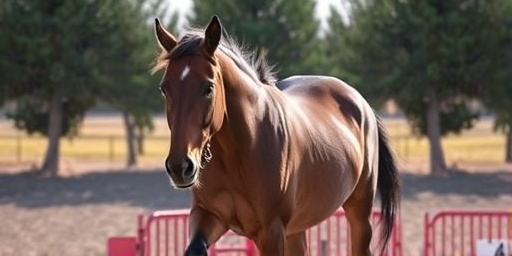Urgent quarantines have been declared across multiple U.S. states following a fresh outbreak of Equine herpesvirus Myeloencephalopathy (EHM), the severe neurological form of the highly contagious Equine herpesvirus. Health officials report at least 25 confirmed cases in horses, with exposed animals isolated on 15 premises to curb the EHM outbreak. The virus, known for causing sudden paralysis and death in horses, has disrupted equestrian events and raised alarms in the animal health community.
- California Epicenter: Multiple Ranches Quarantined Amid Rising Cases
- Spread to Colorado and New Mexico: Interstate Travel Fuels Concerns
- EHM Symptoms Escalate Quickly: From Fever to Fatal Paralysis
- Veterinary Community Mobilizes: Urgent Calls for Biosecurity Overhaul
- Industry Reels from Event Cancellations and Long-Term Recovery Plans
This horse disease emerged rapidly after a major horse show in California, prompting state veterinarians to act swiftly. The U.S. Department of Agriculture’s Animal and Plant Health Inspection Service (APHIS) has issued travel restrictions, affecting thousands of horses nationwide. “This is a serious threat to equine populations,” said Dr. Lydia Ramirez, California’s State Veterinarian, in a press release. “We are mobilizing all resources to contain it.”
California Epicenter: Multiple Ranches Quarantined Amid Rising Cases
California, the heart of the U.S. horse industry with over 500,000 horses, has imposed the strictest quarantine measures. Ten premises in Riverside, San Bernardino, and Los Angeles counties are under lockdown after confirming 12 EHM cases. The index case was identified on October 15 at a 200-horse competition in Temecula, where the affected mare showed initial fever and nasal discharge before progressing to hindlimb ataxia.
State officials have traced secondary exposures to 150 horses that attended the event. “All movement is halted until clinical signs resolve and tests clear,” explained Ramirez. Quarantined facilities must implement twice-daily monitoring, with veterinary inspections mandatory. Horses testing positive via PCR for Equine herpesvirus type 1 (EHV-1) are humanely isolated, and euthanasia has been recommended in severe cases to prevent suffering.
Local breeders report significant disruptions. Johnathan Hale, owner of Hale Stables in Riverside, shared, “We’ve canceled all trail rides and lessons. This equine herpesvirus doesn’t discriminate—it’s hit our show horses hardest.” Economic estimates peg losses at $2 million already, factoring in forfeited competitions and veterinary costs averaging $5,000 per case.
Spread to Colorado and New Mexico: Interstate Travel Fuels Concerns
The EHM outbreak has jumped state lines, triggering quarantines in Colorado and New Mexico. In Colorado, five cases linked to a horse shipped from California were confirmed near Denver. The Jefferson County Fairgrounds, site of a recent rodeo, is ground zero, with 40 exposed horses restricted. Colorado’s Chief Veterinarian, Dr. Emily Thornton, announced, “We’ve issued a statewide hold order on equine transport from affected areas.”
New Mexico reports eight cases in Albuquerque and Santa Fe counties, tied to a cutting horse event. Four ranches are quarantined, impacting 120 horses. “The virus spreads via respiratory droplets and fomites—shared tack, trailers, anywhere,” noted Dr. Miguel Ortiz, New Mexico’s animal health director. Interstate highways like I-40 have become inadvertent vectors, with haulers now required to disinfect rigs per APHIS protocols.
- Colorado Quarantine Details: No equine events until December; all imports need negative EHV-1 tests.
- New Mexico Actions: Mandatory reporting of feverish horses; contact tracing expanded to 300 animals.
- Shared Challenges: Both states face shortages of specialized equine neurologists amid surging demand.
APHIS data shows EHM cases have tripled since 2020, underscoring vulnerabilities in high-density horse gatherings. Travel bans extend to adjacent states like Arizona and Utah as a precaution.
EHM Symptoms Escalate Quickly: From Fever to Fatal Paralysis
Equine Herpesvirus Myeloencephalopathy strikes with deceptive speed, evolving from mild horse disease symptoms to life-threatening conditions. Caused by a mutant strain of EHV-1, EHM targets the central nervous system, leading to myeloencephalopathy—inflammation of the spinal cord and brain.
Initial signs mimic a common cold: fever above 102°F, lethargy, and clear nasal discharge. Within 24-48 hours, neurological deficits emerge—hindquarter weakness, urine dribbling, and recumbency. “It’s heartbreaking; horses go from prancing to unable to stand overnight,” said Dr. Sarah Kline, an equine infectious disease specialist at Colorado State University.
- Day 1-2: Respiratory phase with cough and edema in hindlegs.
- Day 3-5: Ataxia, head tilt, and bladder atony.
- Beyond Day 5: 30-50% mortality rate; survivors face prolonged rehab.
Diagnosis relies on PCR testing of nasal swabs or cerebrospinal fluid, with supportive care including IV fluids, anti-inflammatories, and anti-virals like valacyclovir. Vaccination against EHV-1 offers partial protection but doesn’t fully prevent EHM, per the American Association of Equine Practitioners (AAEP).
Veterinary Community Mobilizes: Urgent Calls for Biosecurity Overhaul
The animal health sector is rallying with enhanced surveillance. The AAEP has activated its EHM Task Force, issuing guidelines updated post-outbreak. “Boost biosecurity: handwashing, no shared water buckets, and 10-day isolation for new arrivals,” urged Task Force Chair Dr. Peter Timoney.
Quotes from the frontlines highlight the strain:
“This EHM outbreak reminds us of 2011’s devastation—over 160 cases nationwide. We can’t afford complacency.” – Dr. Lydia Ramirez, CA State Vet.
“Owners must vaccinate annually and monitor temps daily. Early detection saves lives.” – Dr. Emily Thornton, CO Chief Vet.
Federal aid includes $1.5 million from USDA for testing kits and mobile labs. Private insurers like Markel Equine report a 40% spike in equine herpesvirus claims, prompting premium hikes.
Industry Reels from Event Cancellations and Long-Term Recovery Plans
The equestrian economy, valued at $122 billion annually, faces a body blow. The Temecula show alone generated $500,000; now, 20+ events from rodeos to dressage competitions are postponed through 2024. The American Quarter Horse Association canceled its World Show qualifiers, affecting 10,000 entrants.
Breeders in quarantined zones can’t sell or breed, stalling a market where foals fetch $20,000+. “Supply chain disruptions hit feed and vet suppliers too,” said National Horse Association CEO Tom O’Mara. Mental health tolls on owners are mounting, with support hotlines launched.
Looking ahead, states plan phased liftings: premises clear after 21 days symptom-free and negative tests. APHIS vows genomic sequencing to track strains, while research at UC Davis explores EHV-1 vaccines. Horse owners are urged to join reporting networks like Equine Disease Communication Center (EDCC).
Recovery hinges on vigilance. “We’ll emerge stronger with better protocols,” Kline predicted. As winter nears, colder weather may slow spread, but experts warn of indoor stabling risks. Stakeholders eye 2025 with cautious optimism, prioritizing animal health to safeguard the equine world’s future.









